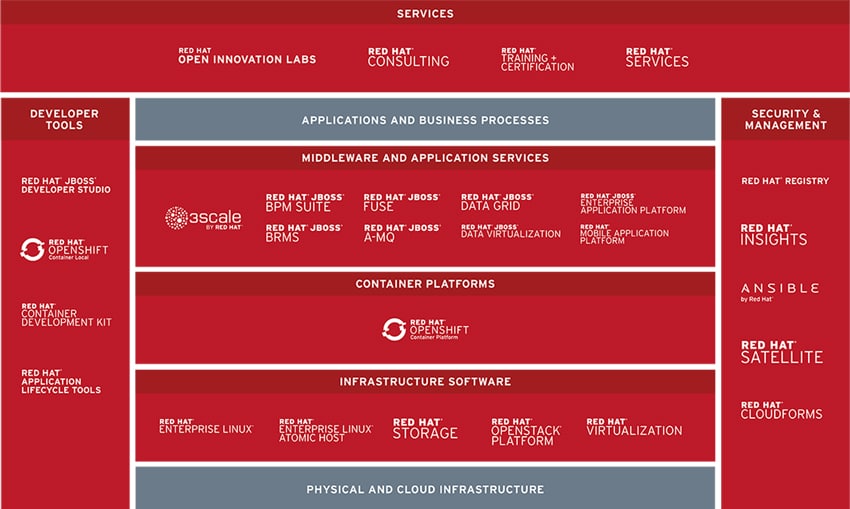 Today at the OpenStack Summit Sydney 2017, Red Hat Inc. announced the latest version of its massively-scalable and agile cloud Infrastructure-as-a-Service (IaaS), Red Hat OpenStack 12. This new IaaS is based off of OpenStack’s Pike release, and introduces containerized services, improving flexibility while decreasing complexity for faster application development. Red Hat OpenStack 12 also comes with a slew of new enhancements such as an upgraded DCI (distributed continuous integration) and improved security to help maintain data compliance and manage risk.
Today at the OpenStack Summit Sydney 2017, Red Hat Inc. announced the latest version of its massively-scalable and agile cloud Infrastructure-as-a-Service (IaaS), Red Hat OpenStack 12. This new IaaS is based off of OpenStack’s Pike release, and introduces containerized services, improving flexibility while decreasing complexity for faster application development. Red Hat OpenStack 12 also comes with a slew of new enhancements such as an upgraded DCI (distributed continuous integration) and improved security to help maintain data compliance and manage risk.
Today at the OpenStack Summit Sydney 2017, Red Hat Inc. announced the latest version of its massively-scalable and agile cloud Infrastructure-as-a-Service (IaaS), Red Hat OpenStack 12. This new IaaS is based off of OpenStack’s Pike release, and introduces containerized services, improving flexibility while decreasing complexity for faster application development. Red Hat OpenStack 12 also comes with a slew of new enhancements such as an upgraded DCI (distributed continuous integration) and improved security to help maintain data compliance and manage risk.

The latest version of Red Hat OpenStack builds off of the enterprise-grade backbone of Red Hat Enterprise Linux and is designed for private or public cloud infrastructure. This platform is a tested, certified, and fully-supported version of OpenStack that, according to Red Hat, provides the agility to scale and more quickly meet customer demand without compromising availability, performance, or IT security requirements. Also included in Red Hat OpenStack 12 is Red Hat CloudForms and tight integration with Red Hat Ceph Storage.
A big change to this version is the introduction of the containerization of OpenStack services. Red Hat has been key in bringing containers to the enterprise as well as to open source projects that can benefit from containers. As containers are becoming more popular and even critical in some cases, users want more ways to leverage them. The new platform enables users to run OpenStack services on Linux containers. Red Hat OpenStack 12 can containerize most OpenStack services while offering a containerized Technology Preview of certain networking and storage services.
Red Hat is also using automation to both make its new platform more efficient and more secure. On the efficiency side of things, Red Hat OpenStack 12 is automating its infrastructure enrollment service and its life cycle management for security certificates. On the security side of things, the platform has updated its OpenStack Block Storage (Cinder) and Bare Metal Provisioning (Ironic) with volume encryption support and disk partitioning enhancements, respectively. The company will also outline security features, implementation, and guidance for meeting baseline security controls with the release of its new Red Hat security guide.
The new version also introduces composable networks, meaning users can define the network topology they need with fewer constraints. Red Hat has also removed the upper limit on networks allowing users to create as many as needed, including the popular L3 spine and leaf topology. Red Hat has extended its technology preview of OpenDaylight, a modular open source platform for customizing and automating a software-defined network. With OpenDaylight, customers can increase speed and throughput, while also having more support for Network function virtualization (NFV).
And finally, Red Hat has upgraded its popular Distributed Continuous Integration (DCI) to automatically deliver actionable logs to its quality engineering teams, reducing the amount of time it takes to identify, patch, and introduce fixes back into the upstream community.
Availability
Red Hat OpenStack Platform 12 is scheduled to be available in the coming weeks via the Red Hat Customer Portal and as a component of the Red Hat Cloud Infrastructure and Red Hat Cloud Suite solutions.
Sign up for the StorageReview newsletter
